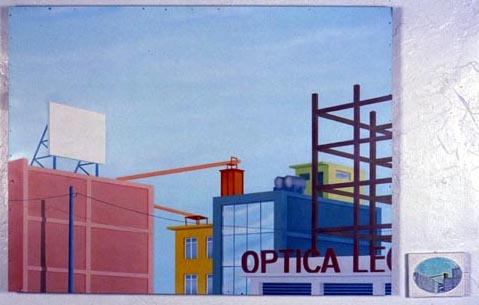Dirty Realism
dal 17/4/2000 al 18/4/2000
Segnalato da
Francis Alys
Oliver Boberg
Claire Corey
Dexter Dalwood
Sue de Beer
Pat de Groot
Joachim Koester
Sarah Morris
Rebecca Quaytman
Fischli & Weiss
Sima Familant
Caitlin Masley
17/4/2000
Dirty Realism
Robert Pearre Fine Art, Tucson, AZ

Francis Alys, Oliver Boberg, Claire Corey, Dexter Dalwood, Sue de Beer, Pat de Groot,
Joachim Koester, Sarah Morris, Rebecca Quaytman, Fischli & Weiss
Curated by Sima Familant & Caitlin Masley
With the onslaught of media, technologies and the millennium, we find ourselves in a new
place where reality is open for a new definition. What we accept and what we are willing to
accept as reality has sent us searching.
This exhibition offers us the new visual and tells us that we no longer need to cling to the
actuality of the now, the conventional. Through a variety of medias, the artists present work
under the premise that authenticity is short sighted.and suggests a desire for a revived
reality. It is this new realism that we want, accept, glamorize and desire. The artists allow us to
believe that this is the true experience which negates the original. Interpretation and an
uncanny resemblance to the aesthetic norm further complicate expectations. By utilizing real
possibilities and everyday surroundings, these works cultivate potential for a new actuality, a
dirty realism.
Francis Alys, in his series of sign paintings, highlights the subjectivity inherent in portraiture
painting. Alys paints an image from a photograph then commissions a sign painter, a cultural
signifier of Mexican locale, to recreate the same image. The two paintings are presented
together and emblematically create the question ‘what is the real image?’. This also occurs in
Oliver Boberg’s photographs of models that he constructs using real and fabricated materials
depicting German landscapes. These stark deliberate constructions are seemingly ordinary
until the realization that Boberg spends over two months perfectly constructing a scene that
is more real than reality. Dexter Dalwood’s work takes this idea of recreating a place one step
further as he paints places he has never seen before. Dalwood’s work deals with the
pseudo-memory lying between fiction and familiarity as in the painting, Hitler’s Bunker
(1999), where he has interpreted the invisible or the unseen place that is a part of the
collective imagination.
Joachim Koester’s work, Day for Night, Christiania (1996) examines a real locale that has
taken on a mythical status. Christiania, an area in Copenhagen that was originally built in the
1960’s as an utopian society, has slowly faded from these once idealistic dreams. Koester
uses a day for night filter, a popular cinematic technique that creates a night scene during the
day. Using this filmic language, Koester acknowledges the divide between the actual and the
mythological through the retelling of the subject matter as narratives. Sarah Morris gives us
image bytes of the city she sees and experiences. As in her painting, Midtown-Marriot
Marquis (1998), Morris processes and deconstructs the city inside and out reducing the
details to color and energy.
Sue de Beer is influenced by the dynamics of the horror scene genre. Her photos become a
surrealist situation recalling a characteristic union of horror films and choreographed body art
pathologies. Claire Corey’s iris jet prints have manipulated an image digitally with the newest
software. This is a distinctive contrast to de Beer’s intentional omission of technology which
allows the viewer to easily discover that the scene is an obvious deception. In Corey’s work,
there is no trickery. Corey paints on the computer screen directly, creating decadent, visual
abstractions Able to create a vibrancy impossible in traditional painting, Corey’s luscious
outputs also illustrate how technology can make painting "better" than it thought possible.
Pat de Groot’s paintings of seascapes create the vision outside her window in Cape Cod
better than actuality. Restricting herself to one painting a day, she stands in the exact same
spot each time subtracting any debris or imperfections. De Groot paints her view of
perfection; her idealized vision of sky and water break down into abstracted blocks of color.
This construction of image and manipulation of the viewer is also what Rebecca Quaytman
controls in her paintings. By placing the viewer between the space we are in now and the
place that she creates in the picture, Quaytman sets up an uncomfortable confrontation
between the image we see and the memory of the original installation of the painting.
Quaytman wants us to realize what we are experiencing by viewing her painting which
includes the previous installation.
Fischli & Weiss have made a career of reconstructing greatness from the ordinary. In their
sculptures and photographs, they arrange everyday simple material and objects that
seemingly drift into our unconsciousness into something out of the ordinary or somewhat
fantastical. As in their garden series photographs, Fischli & Weiss morph different species of
flowers together to make a beautiful hybrid species. They are able to suggest the impossible
while making it look as if it were never not possible.
Today, truth can be manipulated, manufactured, subjective, constructed and technologically
enhanced. Not restricted to didactism and straight interpretation, the works in this exhibition
articulate that the real is not just reality, the very key to dirty realism.
For more information please contact the gallery
ROBERT PEARRE FINE ART 314 East Sixth Street Tucson, AZ



